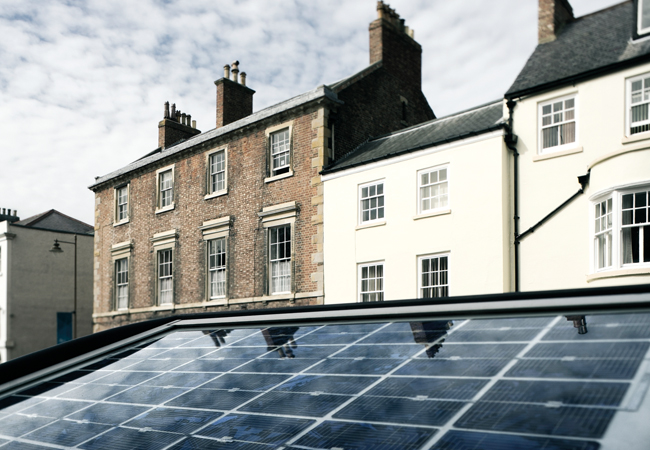
Photovoltaics are part of the solution for the transition from fossil fuels to electricity
Chris Worboys
The electrification of buildings is vital if the UK is to meet its carbon-reduction targets. Visitors to CIBSE Build2Perform Live on 5-6 December can find out what this means for building design by attending a session led by Chris Worboys, senior sustainability consultant at Etude, and Luke Osborne, deputy technical director at Electrical Safety First. Here, they answer questions on the transition from fossil fuels to electricity.
What are the biggest challenges to electrification?
One of the biggest is culture. Design teams often use solutions with which they are familiar, as there is risk and effort associated with new approaches. Air to air heat pumps are huge in Europe because they have high efficiencies and offer a cheap entry point into low carbon heating, yet they remain a niche product in the UK.
Lack of understanding of tariffs is also a problem. Grid imports can range from negative during periods of excess renewable generation to multiples of the average price at peak times, while onsite solar is a fantastic source of cheap electricity. This means electric heating can be much cheaper than fossil-fuel heating, but a building’s systems need to be designed in specific way to achieve this.
Another challenge is the endless promotion of hydrogen for heating by the gas industry, despite an almost total lack of independent evidence that this is a sensible pathway. There is a point at which it becomes necessary, as professionals, to call out technologies that have questionable fundamentals.
How do we avoid being constrained by Grid capacity as we move to electric vehicles (EVs) and heat pumps?
By minimising and managing demand, and investing in the network. Fabric efficiency is vital for new buildings because it reduces electrical demand, but it is difficult and expensive to improve at a later date. There is also good potential to reduce demand through better design and optimisation of building services. For example, by designing systems with domestic hot water storage to reduce peak demands, and space heat distribution that allows heat pumps to operate with load and weather compensation, which can increase efficiency.
Designers need to think carefully about EV charging requirements. For many buildings, a charging rate of 7kW or less may be adequate, while it doesn’t make sense to specify a 50kW DC fast charger for a long-term parking bay.
What can building services engineers do to contribute to electrification?
Projects need engineers who know these systems inside out; who can design systems that run efficiently, with low losses, while using cheap intermittent renewable energy from on- and offsite sources. Training is a big one. Smart control options are developing fast, so designers must establish close relationships with manufacturers to understand the latest technology and what’s coming next.
How important is smart technology?
We are moving to an energy system where demand needs to be scheduled to match supply, rather than supply being scheduled to meet demand. National Grid has been clear that smart technology is vital to manage demand. For a building owner, smart technology is key to accessing cheap and plentiful renewable electricity. Buildings with better fabric efficiency, higher thermal mass, hot water storage, and smart controls will be better able to use onsite solar energy when it is available, and to access offsite renewable energy from the Grid at very low prices.
How do we electrify existing buildings?
In a block of flats, for example, the easy approach might be to use a communal heat pump instead of a gas boiler, but that could mean the system has to operate above 60°C all year to provide domestic hot water. This removes the option of load and weather-compensated flow temperatures, and storing domestic hot water at lower temperatures with sterilisation cycles. These are the main strategies used to maximise the efficiency of heat pumps. Using individual heat pumps, whether standalone or linked to an ambient loop, could operate much more efficiently, and would allow occupants to take advantage of time-of-use electricity tariffs.
- Register for the free to attend Build2Perform at www.build2perform.co.uk

